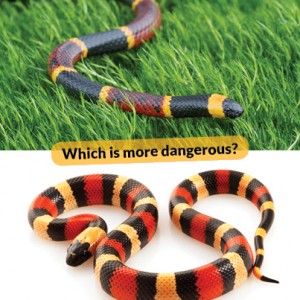
Identifying:
Being able to identify venomous snakes is a great skill to develop. The following infographic from Snake-Removal.com shows what features to watch out for: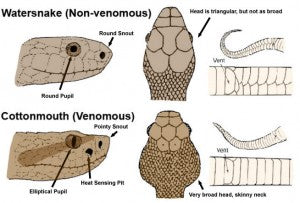
- It has elliptical pupils. A venomous snake will have elliptical, slit-like eyes, resembling a cat, rather than having round pupils.
- It rattles its tail (sometimes). If you hear a snake rattling its tail, get yourself away. Rattling is an immediate sign that you may be in danger of crossing paths with a rattlesnake. Often, harmless snakes will make a rattling sound by dragging their tail through dry leaves. The western rat snake (also called the black rat snake) is one of these. Either way, it’s not worth getting a closer look to see if the snake is dangerous or not.
- It has a broad, triangular head. Venomous snakes typically have broad, triangular heads. This may sound odd because most snake heads look similar, but the difference in shape is seen near the snake’s jaw. A venomous snake will have a bulbous head with a skinny neck because of the position of the snake’s venom sacks underneath its jaw. Harmless snakes have a more gradual sloping jaw because they don’t have venom sacks. Some of them, like the grass and viperine snake, will even flatten their heads as a defense mechanism, to appear venomous to predators. It's an example of why you need to rely on a variety of the factors listed here before definitely identifying a snake as poisonous.
- It has a heat sensing pit. This is a feature that you may not be able to see very well from a distance. The heat sensing pit sits between the eye and nose of venomous snakes. Getting too close to a snake to look for this pit is not a good idea. This sensor is mostly seen on vipers.
- It has a colorful pattern: Generally, most solid colored snakes are harmless. The more colorful and patterned a snake, the more careful around it you should be. Although there are always exceptions to these rules such as the Black Mamba that lives in southern and eastern Africa.
- It behaves a certain way: Snakes act differently from one another. For example, Cottonmouths (or Water Moccasins) and harmless water snakes act differently from one another when they swim. A harmless water snake will swim through the water with just its head poking above the surface. A venomous snake, however, will let its entire buoyant body float along the water. Studying up on different snake behaviors can help you identify a harmless and a harmful snake from a distance.
Snake Types
Rattlesnake: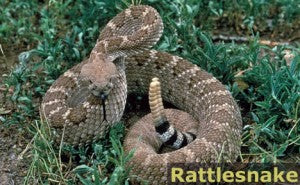
Photo Courtesy of ModernSurvivalBlog.com
The Rattlesnake is the most widely recognized venomous snake in the country. You can easily identify a rattlesnake by the rattling sound it makes as it shakes the rings at the end of its tail. Rattlesnakes can strike out to 2/3 their body length to reach their prey and deliver a venomous bite. A rattlesnake’s hemotoxic venom (which causes blood poisoning) travels through the bloodstream, destroying tissue and degenerating organs while causing swelling, blood clots, internal bleeding, and intense pain. Typically, Rattlesnakes will only bite if they feel threatened. If a rattlesnake bite is treated immediately and the venom is removed, you are more likely to survive the attack. Editor's Note: There is a mini, "horned" relative of the rattlesnake that is important to watch out for, too--the North American sidewinder. Typically living in the deserts of North America, these snakes aren't lethal to humans (due to their small size), but are definitely still venomous. They hide in animal burrows or bury themselves in the sand and primarily come out to hunt at night. You can recognize a sidewinder by the "horns" that sit above it's eyes. These "horns" are actually thought to be an adaptation to protect the snakes eyes from the desert sands. If bitten by a sidewinder, seek medical attention immediately. For more information about sidewinders, visit Desert Animals. Copperhead: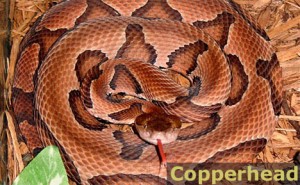
Photo Courtesy of ModernSurvivalBlog.com
The Copperhead is one of the most common venomous snakes in the eastern United States. These snakes are a type of pit viper (fast, quick-tempered, and usually nocturnal) whose bites cause severe pain which can last anywhere from 2-4 weeks. Although a pit viper, the Copperhead is the least toxic and rarely fatal. Copperheads are generally nocturnal creatures, but are excellent at camouflage during the day. If a Copperhead is caught off guard, instead of fleeing (as most snakes do) it will freeze in place. So keep an eye out so you don’t accidentally step on one. Copperheads can produce enough venom to kill a human if they see one as prey; but usually they’ll just give a warning bite if they feel threatened and inject little venom. Cottonmouth: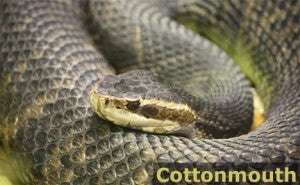
Photo Courtesy of ModernSurvivalBlog.com
The Cottonmouth (also known as a Water Moccasin) is a more dangerous version of the Copperhead. Unlike the Copperhead, who freezes to camouflage itself when caught off guard, the Cottonmouth will stand its ground—and its bite is more serious than the Copperhead’s. Cottonmouths produce a cytotoxic poison, which prohibits the blood from clotting while it destroys tissue and leads to hemorrhaging. A Cottonmouth’s bite can easily be fatal. Coral Snake: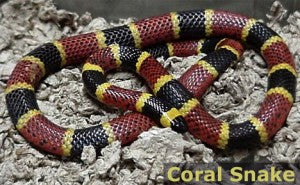
Photo Courtesy of ModernSurvivalBlog.com
The coral snake breaks all the rules—with a unique appearance from the other venomous snakes commonly found in the US. Unlike average venomous snakes, coral snakes don’t have triangular heads, heat sensors, or elliptical pupils, but its color gives it away: Black and red stripes separated by yellow lines. There are other “copycat” snakes that look similar to a coral snake with these same three colors. To help you remember, try learning this mneumonic device: “red next to yellow is a dangerous fellow; red on black, safe from attack.” This snake is the most toxic species found in the U.S. The coral snake has powerful neurotoxin venom meaning it can shut down your nervous system, make your heart stop beating, and ultimately lead to your death. Coral snakes are typically isolated creatures that inhabit unpopulated areas. Only biting as a last resort, these snakes will first and foremost attempt to flee. Their fangs, although deadly, are short and have a difficult time penetrating through thicker materials such as leather. Any penetration to the skin, however, needs immediate medical attention.Treatment
If you are attacked by a venomous snake, seek medical attention immediately. Some snake bites, such as the Coral snake, require large doses of antivenom to prevent death. Without medical attention, the venom will paralyze the victim’s respiratory muscles and breating failure can happen in a matter of hours. If a snake does bite you, the Mayo Clinic recommends the following tips:- Remain calm.
- Immobilize the bitten arm or leg, and stay as still as possible to keep the poison from spreading through your body.
- Remove jewelry before you start to swell.
- Position yourself, if possible, so that the bite is at or below the level of your heart.
- Cleanse the wound, but don’t flush it with water, and cover it with a clean, dry dressing.
- Apply a splint to reduce movement of the affected area, but keep it loose enough so as not to restrict blood flow.
- Don’t use a tourniquet or apply ice.
- Don’t cut the wound or attempt to remove the venom
- Don’t drink caffeine or alcohol.
- Don’t try to capture the snake, but try to remember its color and shape so you can describe it, which will help in your treatment.
- Call 911 or seek immediate medical attention (especially if the area changes color, begins to swell, or is painful).
- Survival 101: Foraging for Edible Plants
- Hunting Snares: Types and How to Build One
- Hunger Games Survival Skills Self-Evaluation

44 comments
Anna
Red and yellow, kill a fellow. Red and black, venom lack.
Emergency Essentials
Thank you for your feedback, James. We agree that snakes are amazing creatures! To your point, some will actually rattle their tails in leaves—an incredible behavior to be sure!
Our hope is that through continuing to help people quickly identify venomous snakes, they’ll have no reason to fear the entire species.
We’ve updated our information in a couple spots to reflect your awesome feedback. Thanks again for engaging!
james meadows
This post has so many wrong facts posted its sad. Just because a snake ratgles its tail doesn’t make it a rattle snake, there are many that will shake their tails in leave piles as a warning, including the black rat snake. As for triangular heads on venomous snakes, most have it yes. But you also posted a picture of a eastern coral snake, that does not have a triangular head nor elliptical eyes. You also failed to list the hundreds of species of snakes that flatten their heads to make themselves look more threatening such as the common water snake, the hognose snake and countless others. People, if you are truly interested in finding I formation on snakes, don’t depend on a post by someone like the person who posted this, get books or talk to a herpetologist and get rid of your fear. By the way, for those watching Naked and afraid, water moccasins will NOT chase you.
Hannah Henderson
Rattlesnakes are super cool. I love them. Thx StonyB for the cool info about the rattlesnake. Very interesting.
Hannah Henderson
I almost been bit by rattlesnake. It was really scary. Thank you soo much for this awesome website!!! I am doing a paper on rattlesnakes, so this was super helpful. I really appreciate it. Super cool stuff. Once i was playing hide-and-go-seek in my backyard and i saw a rattlesnake. Super scary. YOu guys have cool coments.
Emergency Essentials
Thank you for the feedback, Rebeccah. We’ll take a look at the Spreading Adder.
Rebeeccah
Why is there ho info on spreading adder in Illinois?
Shawn
Thank you so much for this post. I learned a lot of good benefits from physical appearance and behavior of snakes!
bob
some are aggresive. vottonmouths have came at people in my area. Most.others will run if not cornered.
Nick
A venomous snake bite has two fang marks and regular looking teeth marks that look like a human bite pattern.
Non-venomous bite looks like a human bite with out the two fang marks.
PissedOffVeteran
Read what he said. He said it turned out to be a toad with the same kind of eyes. Read, people. Listen to whole sentences before answering same for reading read it all and pay attention. He told you it was not a snake in his story.
P. S. you didn’t piss me off I just use that email address as it is very secure, out of county server and I taunt liberals so never use my real address.
Katie
Pretty sure snakes aren’t part of your job description. And if there was one, there are likely more so if she cant get ahold of herself she’ll need to move. Or get herself a body guard. Surely you have other things to do.
Ignore the critism. That wasnt fair.
Where is the property? Do you thpically gave venomous snakes?
Thomas McLaurin
A small brown snake was on a rail banister by an apt. tenant’s door on a particular morning. The tenant saw it and started screaming. I went with a shovel and pushed it off the railing and down on the ground. Once I was able to get another scoop on it with my shovel, I tried to toss it into the woods as far as I could but it didn’t go far. It started writhering away. But, I have a question? I am getting some critics that tell me that I should have killed the snake because the tenant is afraid to sit at her front apt door. I put out some moth balls under that railing and spread some lime out in front of the wood line in front of the tenant’s apt. What more should I have done? I’m a maintenance man at our complex. Any advice would help me out to do a better job.
Renae
Moth balls, and moth cakes keeps them away!! I have used them for years! Keeps a lot of things away..
John McConaha
Where I presently live I have killed two copperheads; one in my garage and the other near it. They are always looking for a food source-birds, mice, etc. They also like cover such as a woodpile or lumber pile. As soon as I spot one, I kill it-no sense in taking chances and allowing them to multiply. I skinned the last one I killed and discovered it was a female with at least five young inside her-scarey! I do not kill non poison snakes; they are in competition with the poison snakes for food so I figure less food for the dangerous snakes if I let them live!
John
Alta
It’s actually a great and helpful piece of info.
I am satisfied that you simply shared this useful information with us.
Please keep us up to date like this. Thank you for sharing.
beprepared
Sheila,
Thanks for the tip. I didn’t know that snakes carry Salmonella—that’s crazy! Have you or anyone you’ve known ever experienced a snake bite before? What do doctors do specifically to treat snake bites?
Angela
Shelia
Even non-venomous snakes hurt when they bite and most have salmonella (among other things) and will transmit to humans. Medical attention for any kind of snake bite.
beprepared
Hey Cynthia,
That is a great comment! I can’t believe one chased a guy that far. Through my research I found that sidewinders live in the deserts of North America, Africa, and the Middle East. The North American sidewinder is actually a type of rattlesnake (luckily it’s smaller than regular rattlesnakes!). It’s size is the reason why sidewinders typically aren’t lethal to humans, but they are still venomous. If someone is bit by a sidewinder (or any snake for that matter), the safest thing to do is seek medical attention immediately. Originally I hadn’t covered sidewinders because they aren’t lethal to humans, but I have gone ahead and added some information in. Thanks for your comment.
Kim
Ann
I took great interest in your article because we had a snake in the back yard that I needed to know what kind it was and if it was venomous mainly because of my dog’s sake. My dog goes after anything that goes on the ground and he wanted that snake. Thank you for an insightful article.
beprepared
Robert,
That’s a good question. I am not sure.Does anyone know? Do snakes come out more than usual if there’s flooding?
Angela
beprepared
Stoney B,
Thanks for the comment. I have a question: How did you make out of the situation when you were weeding plants and you were face-to-face with a snake?! What did you do to stay safe? Did you just keep your distance? How’d you get out that situation?
Angela
beprepared
David,
Haha. I could see this being an issue with teenagers. In addition to teenage boys, Who do you all think is the top group most susceptible to getting bitten by snakes? I would think young children might be. Or do you thing that snakes don’t discriminate at all and there’s a pretty even distribution between age groups of who gets bitten? What do you guys think?
Angela
beprepared
Steve,
Thanks for the comment. I love that you use snakes in your home as a type of pest control. How does that work? Are they always loose and slithering about your house? Do you have to warn guests about them before? And how did you come up with the idea? Is this a common thing for people to do?
Angela
beprepared
Bill,
Haha. I love your last sentence about the Garden of Eden. That’s very interesting about the “fresh cut cucumbers” smell. Have you run across a Cottonmouth before and is this how you knew that tip? or did you learn this another way?
Angela
beprepared
Dora,
That’s crazy! Why can’t you call an exterminator? Is it because of their natural habitat/trying to preserve wildlife in the area?
Angela
Dora
Great-We have rattlesnakes and copperheads literally in our back yard and we live in a large city(Atlanta). I have mowed over a few while mowing the yard and our dog has killed a couple. City says we are not allowed to call an exterminator. Just Great!
Cynthia
Duane has it right. You didn’t mention Sidewinders and they are the most aggressive creatures I’ve ever seen. I watched one chase a guy 30 yards before giving up!
Although, having lived in the desert and seen quite a number of snakes, all will attack if they FEEL provoked. Step into a nesting area by accident….Ooops! Or cross the path of a hunting snake….Oooops!
The ONLY way to be sure to not be bitten is to stay as far away as possible. Give them a wide berth and even run away once you’re sure you are out of harm’s way.
Bill
Cottonmouths are aggressive snakes and will come after you if you are invading their territory, so there is NO SUCH THING as leaving them alone. A good way to tell if a cottonmouth is around Is if you smell what appears to be "fresh cut cucumbers". I learned along time ago to leave all snakes alone, but pets and small children do not know these rules, so as adults we must make sure the snakes are not a threat to them. I make it my rule to kill every snake I see .. I really don’t care if some snakes are "beneficial" I hate them all … in fact I’d go so far as to say that if God had put me in the Garden of Eden, there wouldn’t have been a snake around to tempt Eve.
Steve
Having captured nuisance snakes for years for 911, I have learned snakes really just want to be left alone. Large venomous snakes as well as small harmless snakes. Snakes operated best at temps of 65 f to 85 f. Being cold blooded anything more or less slows them down. Cottonmouths often are misunderstood as being aggressive. The have been accused of charging towards people attempting to bite them. This is not the case. They are near sighted and upon receiving heat signals from their pits they make an attempt to see what the heat source is. Rattlesnakes will go the other way if you just allow them to escape. All of the non-poisonous snakes that I caught I released around our home. They are better than Orkin at pest control. Although snake skin is popular for boots and belts, they look much better on the original owner. Thanks for the post. Good info. Treat for shock. If face is pale raise the tail. If face is red, raise the head.
David
A note for you parents; most snake bites happen to teenage boys. It seems that teenage boys just can’t resist poking, prodding, and teasing snakes with the end result of getting bitten. So much for being "macho"!!
Warmil
In most states It is against the law to kill a snake. Check with your local Fish & Wildlife Office or Game Warden. King snakes are very beautifully colored and grow quite large, some five to six feet. The King is famous for eating other snakes including poison ones. If you find a King around be glad he’s there. He’ll keep other snakes, along with the rodent population under control.
StoneyB
I get along well with most all snakes. I find the cottonmouth to be very bad tempered and I try to stay clear. They do usually open wide and display the cotton took of their inner mouths. I try not to kill any venomous snake and because I live in the country I see a great many. If they’re in the house area I might have to dispatch if I can’t convince them to move on off safely. We have a number of rat/chicken snakes living under our house and they do give you a sphincter moment when inspecting the crawl space. My most momentous experience happened when I was on my hands and knees weeding some bean plants. I parted the leaves to reach some grass and was confronted face to face with the bright yellow slitted eyes spaced about two inches apart very remeniscent of a full grown timber rattler. For one second my life flashed before my eyes and I knew I was going to die from a strike between the eyes. It was a large toad that lived in the garden. Same eyes. One of the most interesting snakes we have is the hog-nosed snake. It doesn’t grow much larger that 2-3 feet. It tries to intimidate you with a ferocious display of tail rattling, head flattening like a cobra, open mouth and show of teeth. If that fails it throws up everything it’s ever eaten and evacuates the bowel (not very pleasant). If that fails to make you leave it flops over on its back and shows it’s white belly and then begins to writh and twist in a great acrobatic display. It then ceases all motion and rolls it’s eyes and lets it’s tongue flop out the side of it’s mouth and lies still like it’s dead. You can pick it up and it stays in the limp state. If you back away a bit it will roll over and go it’s merry way. I always enjoy the road show. At any rate respect the snakes and give them space and they’ll do you no harm. Be careful reaching in dark or brushy areas and stepping over downed limbs.
Sorry for the babbling.
robert
if there is flooding will the snakes be out more than usual
Dr.Val Reynolds
Oh yeh , Aggressive BEES & WASPS !
Dr.Val Reynolds
Snakes I had to deal with in Africa & Southern USA, were aggressive ! I suppose calling 911 is NOT an option when SHTF
lbj
RED NEXT TO YELLOW IS A DANGEROUS FELLOW…..how to the poisonous coral snake…..
beprepared
Duane,
Thanks for your comment. Has anyone else found that “snakes aren’t malicious” or is everyone thinking to just stay away from them all? What do you guys think?
Angela
Duane
Much of that is interesting information, however, I must disagree with a couple of points in the article and comments. First, many non-venomous snakes are colorful. Ribbon, garter, rat snakes and king snakes can all be very colorful. much more than a rattlesnake or cottonmouth. I saw an exhibit of king snakes and was amazed by the numerous, different colorations.
Second, "snakes aren’t malicious"…I live in south Louisiana where almost everything is malicious. I’ve known many people who have encountered very aggresive cottonmouth and copprhead snakes. I’ve been told that a snake will leave if it knows someone’s around, but that hasn’t been my experience with cottonmouth snakes. Maybe northern snakes are friendlier :)
beprepared
David and Angela,
If I ever saw a snake, I would leave it alone, too. The purpose of our post is not to say “if you see a venomous snake, kill it” (that could have a lot of outcomes that are not safe). We are simply trying to inform people of the differences and to be able to distinguish between the two types of snakes. We realize that if you are faced with the situation in the wild that it may be hard to tell which snake is which, but the purpose of this is for knowledge and study. Yes, it is safe and a general rule to stay away from all snakes if you aren’t sure, but this is good knowledge to have as well.
Angela
Angela
David has it right – many of these tips can’t really help in the wild unless you have both versions of snake sitting side by side. It’s safest to assume it’s venomous, and just get away from it – they are not malicious, but if the snake is not near your home, children, animals or livestock, just leave it be. Unless you are well versed with types of snakes (I used to work with them), never assume it’s safe. And even a "non-venomous" snake can cause a lot of damage with its bite, as they all have reactive molecules in their saliva, which can cause swelling , allergic reactions and infection just like a mammal bite. Don’t go out of your way to kill a snake, just try to stay out of their way.
david
When I was in the Army, they told us to leave all snakes alone. Don’t even try to identify which are poisonous or not. Just leave them all alone. Same with mushrooms. Don’t eat any of them. Don’t try to identify which are poisonous or not.
Peace.
beprepared
Aubrey,
Very interesting. Do you know specifically what the differences in the patterns look like or are? Could you explain them to us?
Angela
Aubrey
Venomous snakes have a different bite pattern then non-venomous snakes. Knowing the difference is useful because, if something does bite you, you know how much trouble you’re in.